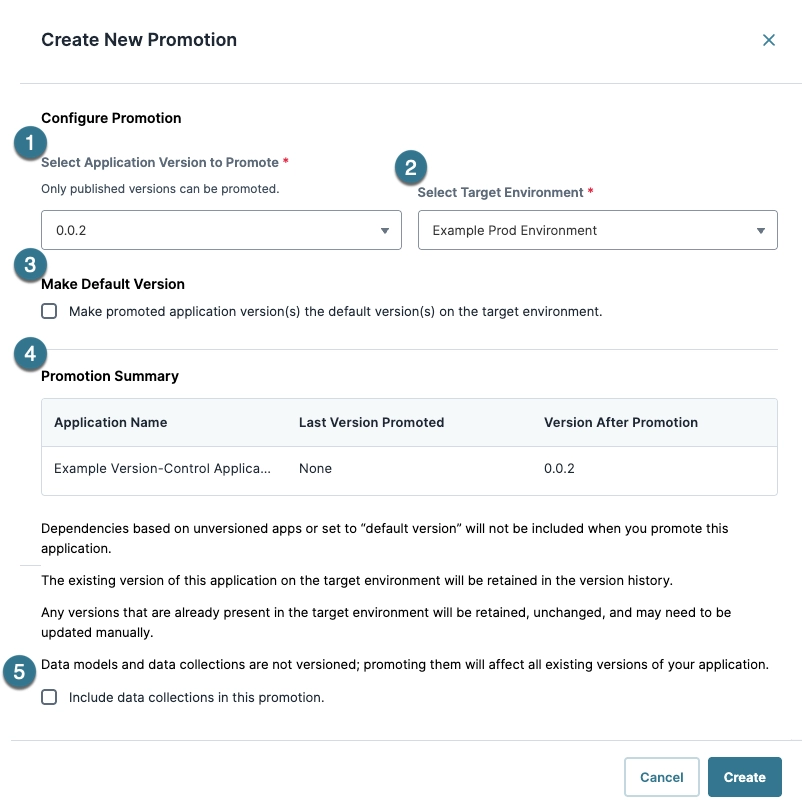The Promotions and Versions page displays promotion history for applications in current and target environments. It also displays the default application version for the current environment.
This page contains the following tabs:
Promotion History: Promote an application to a different environment or view a list of promoted applications.
Set Default Version: Select the default application version for the current environment.
The Promotions and Versions page is only available for versioned applications. Learn more in our Introduction to Application Versioning article.
Access the Promotions and Versions Page
To access the Promotions and Versions page:
Navigate to a versioned application.
At the top right, click the
 (ellipsis) button.
(ellipsis) button.Select Promotions and Versions. You’ll navigate to the Promotions and Versions page in a new tab.

Promotions and Versions Page
Promotion History
The Promotion History page lets Creators create new promotions or view existing promotions and their dependencies. Creators promote versioned applications to other environments, like QA or Production. After promoting, the promotion displays on the Promotion History table. Target environments also display the promoted application in their Promotion History list.

# | Setting | Description | |
|---|---|---|---|
1 | Create New Promotion | Click to open the Create New Promotion modal.
| |
2 | Sort By | Sort the application by the following values:
| |
3 | Filter By | Filter the list by the promotion Type (direction). Types include:
| |
4 | Promotion History Table | The Promotion History table lists promotions into and out of the environment. If no promotions exist, then this table does not display. | |
↳ | Promotion Date | The date and time of the promotion. | |
Type | The direction of the promotion. Application direction includes:
| ||
Target | Displays the environment the application was promoted to. | ||
Version Promoted | The application version that was promoted. | ||
Dependencies | Displays the total dependencies promoted with the application. If no dependencies are promoted, it displays | ||
Promoted By | Displays the user who promoted the application. Displays | ||
Actions | Displays the View Dependencies button. Click to open a modal displaying the application’s Dependencies list.
| ||
Create a New Promotion Modal
The Create New Promotion modal lets Creators select an existing application version to promote to a target environment. Optional settings include setting the promoted application to be the default version and including dependencies in the promotion.

# | Setting | Description | |
|---|---|---|---|
1 | Select Application Version to Promote | Click to display a drop-down list of application versions that can be promoted. This list is limited to the current application. | |
2 | Select Target Environment | Select an environment from the drop-down menu. When the promotion is created, the Target environment receives the promoted application. | |
3 | Make Default Version | After promoting, it sets the promoted application version to be the default version of the application. | |
4 | Promotion Summary | Displays a summarized view of the promotion, including the application, previous version, and version to promote to. | |
↳ | Application Name | The name of the Unqork application. | |
Last Version Promoted | Displays the previous promotion version. If this is the application’s first promotion, then this field displays | ||
Version After Promotion | Displays the version to promote. This value matches the Select Application Version to Promote value. | ||
5 | Include Data Collections in This Promotion | Select this box to include Data Collections in the promotion. If no Data Collections exist, nothing occurs. | |
Promotion History
The Set Default Version tab lets you select the default version of your application for the environment. The default version loads in Express View whenever a context is not provided in the URL. It also sets the version that other applications use if they have the default application set as a dependency. In the Production environment, the default version is the one that is available to end-users. Setting the default version lets you update your end-user experience across any published version without promoting or rolling back your configuration.
Below are the columns you’ll see on this page:
Column | Description |
|---|---|
Application Name | The name of the versioned application that was promoted. |
Latest Version | The most recent version that was deployed. |
Default Version | The version that is set as the default. |
Select Default Version | If you wish to change the default version, click Select Default Version to change it. |
View | Click this button to view the promoted version. |
Reverting to a Previous Version
If a recently promoted version introduced an issue into the next environment, Creators must identify and fix it in the Staging environment. Until the fix is completed, it’s desirable to remove the issue from the higher environment. You’ll set the previous stable version as the Default Version in the Set Default Version tab of the Promotions and Versions page. That way, you can rollback or revert to a previous version. This option is available at all environment levels.
Learn more about Promotion and Version control in our Introduction to Promoting Versioned Applications article.